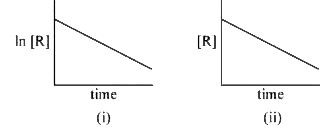The given plots represent the variation of the concentration of a reactant R with time for different reactions (i) and (ii). The respective orders of the reactions are:

1,0
0,2
1,1
0,1
The correct Answer is:A
R→P
a o
a−x x
For 1st order reaction
+dxdt=k(a−x)1

∫dxa−x=∫kdt
− In (a−x)=kt+c
If t=0
C=- In a ∴− In (a−x)=kt−In a
or In (a-x) =-kt+ In a
Y m x c
Similarly
R(Ao)(A)→P
−d[R]dt=k[R]o or −d(R)=kdt or ∫d[R]=−∫kdt
[R]=−kt+c or [A]=−kt+c
y=m x + c

Similar Questions
The given plots represent the variation of the concentration of a reactant R with time for two different reaction (i) and (ii) The respective orders of the reactions are

View SolutionThe given plots represent the variation of the concentration of a reactant R with time for different reactions (i) and (ii). The sum of orders of the reactions is ________ .

View Solution
Knowledge Check
The given plots represent the variation of the concentration of a reactant R with time for two different reaction (i) and (ii) The respective orders of the reactions are
 A1,0B1,1C0,1D0,2
A1,0B1,1C0,1D0,2For a first order reaction, the concentration of reactant :
Ais independent of timeBvaries linearly with timeCvaries exponentially with timeDNoneFor a second order reaction, half-life concentration of reactants:
AIndependent of initial concentration of reactantsBDirectly proportional to concentration of reactantsCInversely proportional to concentration of reactantsDInversely proportional to the square of concentration of reactants
In a reaction if the concentration of reactant A is tripled, the rate of reaction becomes twenty seven times. What is the order of reaction?
View SolutionIn a reaction if the concentration of reactant A is tripled, the rate of reaction becomes twenty seven times. What is the order of reaction?
View SolutionIf the concentration of the reactants is increased, the rate of reaction for first order-
View SolutionFor a given reaction the logarithm of the concentration of the reactant plotted against time gave a straight line with negative slope . The order of the reaction is
View SolutionIn a reaction, when the concentration of reactant is increased two times, the increase in rate of reaction was four times. Order of reaction is :
View Solution
